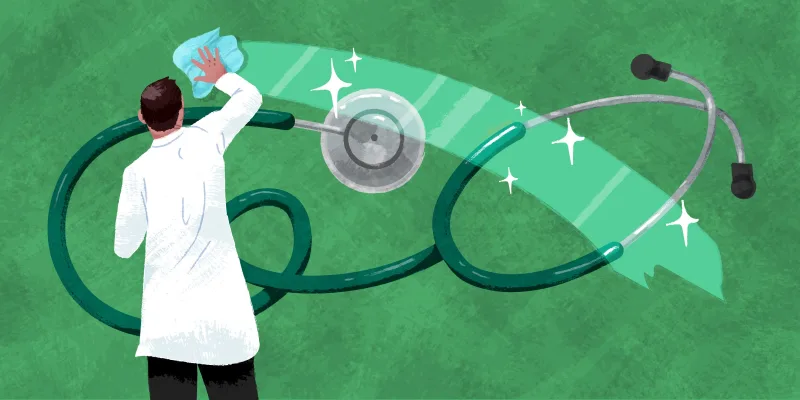
Pain—something we, as doctors, all deal with in the patient context every day, from a safe distance. Aside from the brief pain of my daughter's birth, and mild injury pain in the past, pain is new to me. Today, I am a post-surgical patient and opioid naïve, struggling with the choice between continuing to risk being a number in the opioid crisis, or struggling with another sleepless night if I opt against opioids.
Is my pain a 10 out of 10? No. But it is life-limiting, focus-limiting, sleep-limiting, and treatable with an oxycodone (on top of the maximum acetaminophen dose and ice packs I use now).
Sixteen days ago I underwent right rotator cuff repair, acromioplasty, and biceps tenodesis after a pair of hard falls from my tall, rambunctious, young horse left me with acute and worsening shoulder pain and dysfunction. My surgeon warned me to expect a difficult first month, at least four weeks with my dominant arm in a sling, no driving for four to six weeks, and no riding for six months (curses!). The time I should expect to take off work was nebulous—probably four weeks, give or take. We didn't talk specifically about pain levels. I worried more about limitations on my life, especially given the fact that I am, usually, very active, capable, and self-sufficient. I focused on things like finding drivers, shoppers, and caretakers for myself and my daughter.
But there's no way to prepare for pain; everyone experiences it differently. How would it affect my life? How much pain medicine would I need? Would I get hooked? Alcoholism runs in my family, likely putting me at higher risk for opioid addiction. Plus, I am a redhead! My preteen daughter, whose father died of alcoholism, worried that I would get "hooked." A family friend whom she idolized passed away last year from an overdose. I did my best to reassure her that that would not happen, but her concern is valid.
Opioid-naive patients undergoing surgery who receive peri- and post-operative opioids are at risk, as we know from the deluge of evidence in our literature. In some discussions, the profession of Anesthesiology gets partial blame for the opioid crisis. My surgeon and I did not talk about this risk pre-operation. I assume he assumed, reasonably, that as an Anesthesiologist, I already knew the risks.
My interscalene block gave me great relief for the first 18-20 hours post-op, but I knew there would be at least a few days of oxycodone. I think I got good advice in the post-anesthesia care unit from my great nurse and surgeon, but I just do not recall much after general anesthesia and a post-op dose of promethazine. I started round the clock acetaminophen promptly, and oxycodone late the night of surgery. No NSAIDS were recommended due to risk of impaired healing with regular use.
Veritable bowel paralysis accompanied the oxycodone, despite regular docusate. I took the oxycodone for four or five days, in a decreasing dose, and then decided that I had to stop due to the bowel situation. Acetaminophen, icing, and a little white-knuckling sufficed for about a week. Bowel lockdown and the subsequent need for laxatives and their fallout (sic) seemed much worse than the pain at that point.
Unfortunately, as life goes, so goes healing from rotator cuff repair. A few good days were followed by a few bad—perhaps my increasing activity, perhaps the normal healing process, perhaps karma for any number of past behaviors—and the pain recrudesced. Nighttime was particularly bad, as is typical of pain. No more oxy, I swore to myself. I can do it. That stuff is evil—and everyone with whom I spoke agreed.
How does anyone ever get addicted to this stuff? But after several nights of very little and very poor sleep, the thought of returning to oxycodone crept in. Pain is exhausting, and I have a better appreciation of my patients' pain now. Lack of sleep worsened my pain, or at least eroded my coping mechanisms. Eventually, I gave in and took an oxycodone at bedtime, wrestling with whether to do it all the way up until the pill went into my mouth and down with the water. I felt like a failure. But hallelujah, I slept better, and that was a big win.
Now I take one oxycodone at bedtime with acetaminophen. I hope my acute awareness of the addiction potential will protect me from my risk, and that I will be done with them soon. If I were not aware, not motivated to get back to work and life, would I be taking more? Probably. My concern is probably overblown. But I have a better understanding now of how distracting ongoing pain is, and how the worry about what is wrong (have I torn the repair?) compounds the problem.
The profession-wide campaign in medicine to decrease opioid addiction is a great start, though imperfectly implemented at this point. In my state of North Carolina, the legislature enacted prescribing guidelines to curb misuse and overprescribing. They are imperfect as well, but a reasonable first step. Since physicians are exposed regularly—clinically, online, in journals, and in professional lectures—about the epidemic, our awareness is ever increasing. But how about our patients' awareness? I admit that I had not looked at it through that lens until now. Do you counsel your patients about the risks of opioid use, and how to minimize them, when prescribing post-procedural opioids? If your patient has received general anesthesia or other sedation, his/her recall of the discussion may be limited, and accompanying family members may not take note of the discussion (mine did not—another story). Please consider the opioid-risk-management discussion carefully in your pre-operative visit.
My new perspective increases the urgency of this issue for me. It is personal for millions of patients with increasing frequency. Please do everything you can to prepare yours.
Dr. Bodin is academic Anesthesiologist in Winston Salem, NC. Some of her professional interests are the patient experience, teamwork issues, and healthcare reform. She is a mother, athlete, and equestrian.







